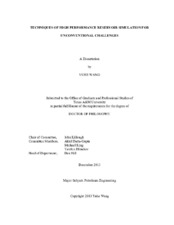| dc.contributor.advisor | Killough, John | |
| dc.creator | Wang, Yuhe | |
| dc.date.accessioned | 2014-05-13T17:27:08Z | |
| dc.date.available | 2014-05-13T17:27:08Z | |
| dc.date.created | 2013-12 | |
| dc.date.issued | 2013-12-05 | |
| dc.date.submitted | December 2013 | |
| dc.identifier.uri | https://hdl.handle.net/1969.1/151858 | |
| dc.description.abstract | The quest to improve the performance of reservoir simulators has been evolving with the newly encountered challenges of modeling more complex recovery mechanisms and related phenomena. Reservoir subsidence, fracturing and fault reactivation etc. require coupled flow and poroelastic simulation. These features, in turn, bring a heavy burden on linear solvers. The booming unconventional plays such as shale/tight oil in North America demand reservoir simulation techniques to handle more physics (or more hypotheses). This dissertation deals with three aspects in improving the performance of reservoir simulation toward these unconventional challenges.
Compositional simulation is often required for many reservoir studies with complex recovery mechanisms such as gas inject. But, it is time consuming and its parallelization often suffers sever load imbalance problems. In the first section, a novel approach based on domain over-decomposition is investigated and implemented to improve the parallel performance of compositional simulation. For a realistic reservoir case, it is shown the speedup is improved from 29.27 to 62.38 on 64 processors using this technique.
Another critical part that determines the performance of a reservoir simulator is the linear solver. In the second section, a new type of linear solver based the combinatorial multilevel method (CML) is introduced and investigated for several reservoir simulation applications. The results show CML has better scalability and performance empirically and is well-suited for coupled poroelastic problems. These results also suggest that CML might be a promising way of precondition for flow simulation with and without coupled poroelastic calculations.
In order to handle unconventional petroleum fluid properties for tight oil, the third section incorporates a simulator with extended vapor-liquid equilibrium calculations to consider the capillarity effect caused by the dynamic nanopore properties. The enhanced simulator can correctly capture the pressure dependent impact of the nanopore on rock and fluid properties. It is shown inclusion of these enhanced physics in simulation will lead to significant improvements in field operation decision-making and greatly enhance the reliability of recovery predictions. | en |
| dc.format.mimetype | application/pdf | |
| dc.language.iso | en | |
| dc.subject | Reservoir Simulation | en |
| dc.subject | Parallel Compositional Simulation | en |
| dc.subject | Linear Solver | en |
| dc.subject | Tight Oil | en |
| dc.title | Techniques of High Performance Reservoir Simulation for Unconventional Challenges | en |
| dc.type | Thesis | en |
| thesis.degree.department | Petroleum Engineering | en |
| thesis.degree.discipline | Petroleum Engineering | en |
| thesis.degree.grantor | Texas A & M University | en |
| thesis.degree.name | Doctor of Philosophy | en |
| thesis.degree.level | Doctoral | en |
| dc.contributor.committeeMember | Datta-Gupta, Akhil | |
| dc.contributor.committeeMember | King, Michael | |
| dc.contributor.committeeMember | Efendiev, Yalchin | |
| dc.type.material | text | en |
| dc.date.updated | 2014-05-13T17:27:08Z | |


